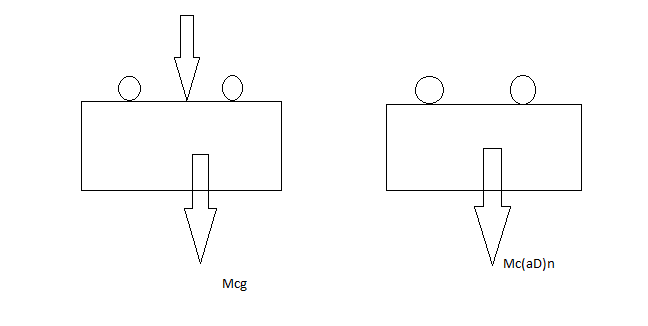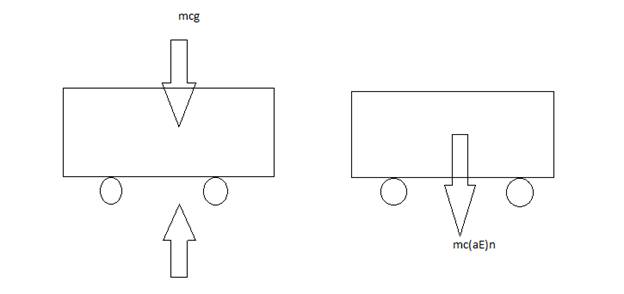
Concept explainers
In Prob. 13.42. determine the range of values of h for which the roller coaster will not leave the track at D or E, knowing that the radius of curvature at E is
The range of values of h for which the roller coaster will not leave the track.
Answer to Problem 13.43P
The value of range of h is 50ft
Explanation of Solution
Given information:
Radius of curvature at point E is=75ft.
Consider free body diagram of the roller coaster at point D.

Resolve the forces acting on the rider by Newton’s second law.
Apply the principle of work and energy to the roller coaster at point A and point D.
Find the resultant acceleration acting on the coaster at the point B is
The coaster is at rest at position A,
Kinetic energy of the rider at point D is,
Work done by the rider in reaching position D from position A,
Substitute above values we get,
Resultant acceleration acting on the rider at point D travelling in a circular track with radius of curvature r.
The normal force acting on the coaster at point D should be greater than zero.
For the roller coaster to not leave the track,
Consider free body diagram roller coaster at point E as shown below:

Resultant acceleration acting on the roller coaster at the point E downwards is
Resolve the forces acting on the coaster by Newton’s second law at point E.
Apply the principle of work and energy to the roller coaster at point A and point E.
Find the resultant acceleration acting on the coaster at the point E is
The coaster is at rest at position A.
Kinetic energy of the rider at point E is,
Work done by the rider in reaching position E from position A.
Substituting the above values we get,
Resultant acceleration acting on the rider at point E travelling in a circular track with radius of curvature
The normal force acting on the coaster at point E should be greater than zero.
For the roller coaster to not leave the track,
Substituting the above values we get,
The range of values for h is
Want to see more full solutions like this?
Chapter 13 Solutions
Vector Mechanics for Engineers: Dynamics
- The primary material used in the production of glass products is silica sand. True or Falsearrow_forwardWhich one of the following is the most common polymer type in fiber-reinforced polymer composites? thermosets thermoplastics elastomers none of the abovearrow_forwardA pattern for a product is larger than the actual finished part. True or Falsearrow_forward
- Two forces are applied as shown to a hook support. The magnitude of P is 38 N. 50 N 25° DG a 터 Using trigonometry, determine the required angle a such that the resultant R of the two forces applied to the support will be horizontal. The value of a isarrow_forwardNo chatgpt pls will upvotearrow_forward101 the three shafts if the diameter ratio is 2 (D/d = 2)? Ans. na, tension = 1.21, na, bending = 1.19, na, torsion = 1.17. 6.32 A material with a yield strength of S₁ = 350 MPa is subjected to the stress state shown in Sketch c. What is the factor of safety based on the maximum shear stress and distortion energy theories? Ans. For MSST, n, = 11.67. 50 MPa 85 MPa 20 MPa 70 MPa Sketch c, for Problems 6.32 and 6.33arrow_forward
- Can you draw the left view of the first orthographic projectionarrow_forwardImportant: I've posted this question twice and received incorrect answers. I've clearly stated that I don't require AI-generated working out. I need a genuine, expert-written solution with proper working. If you can't provide that, refer this question to someone who can please!. Note: Please provide a clear, step-by-step handwritten solution (no AI involvement). I require an expert-level answer and will assess it based on quality and accuracy with that I'll give it a thumbs up or down!. Hence, refer to the provided image for clarity. Double-check everything for correctness before submitting. Thank you!arrow_forwardNote: Please provide a clear, step-by-step simplified handwritten working out (no explanations!), ensuring it is done without any AI involvement. I require an expert-level answer, and I will assess and rate based on the quality and accuracy of your work and refer to the provided image for more clarity. Make sure to double-check everything for correctness before submitting appreciate your time and effort!. Question:arrow_forward
 Elements Of ElectromagneticsMechanical EngineeringISBN:9780190698614Author:Sadiku, Matthew N. O.Publisher:Oxford University Press
Elements Of ElectromagneticsMechanical EngineeringISBN:9780190698614Author:Sadiku, Matthew N. O.Publisher:Oxford University Press Mechanics of Materials (10th Edition)Mechanical EngineeringISBN:9780134319650Author:Russell C. HibbelerPublisher:PEARSON
Mechanics of Materials (10th Edition)Mechanical EngineeringISBN:9780134319650Author:Russell C. HibbelerPublisher:PEARSON Thermodynamics: An Engineering ApproachMechanical EngineeringISBN:9781259822674Author:Yunus A. Cengel Dr., Michael A. BolesPublisher:McGraw-Hill Education
Thermodynamics: An Engineering ApproachMechanical EngineeringISBN:9781259822674Author:Yunus A. Cengel Dr., Michael A. BolesPublisher:McGraw-Hill Education Control Systems EngineeringMechanical EngineeringISBN:9781118170519Author:Norman S. NisePublisher:WILEY
Control Systems EngineeringMechanical EngineeringISBN:9781118170519Author:Norman S. NisePublisher:WILEY Mechanics of Materials (MindTap Course List)Mechanical EngineeringISBN:9781337093347Author:Barry J. Goodno, James M. GerePublisher:Cengage Learning
Mechanics of Materials (MindTap Course List)Mechanical EngineeringISBN:9781337093347Author:Barry J. Goodno, James M. GerePublisher:Cengage Learning Engineering Mechanics: StaticsMechanical EngineeringISBN:9781118807330Author:James L. Meriam, L. G. Kraige, J. N. BoltonPublisher:WILEY
Engineering Mechanics: StaticsMechanical EngineeringISBN:9781118807330Author:James L. Meriam, L. G. Kraige, J. N. BoltonPublisher:WILEY





